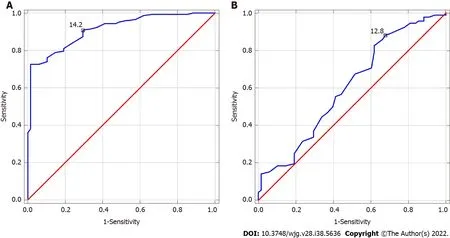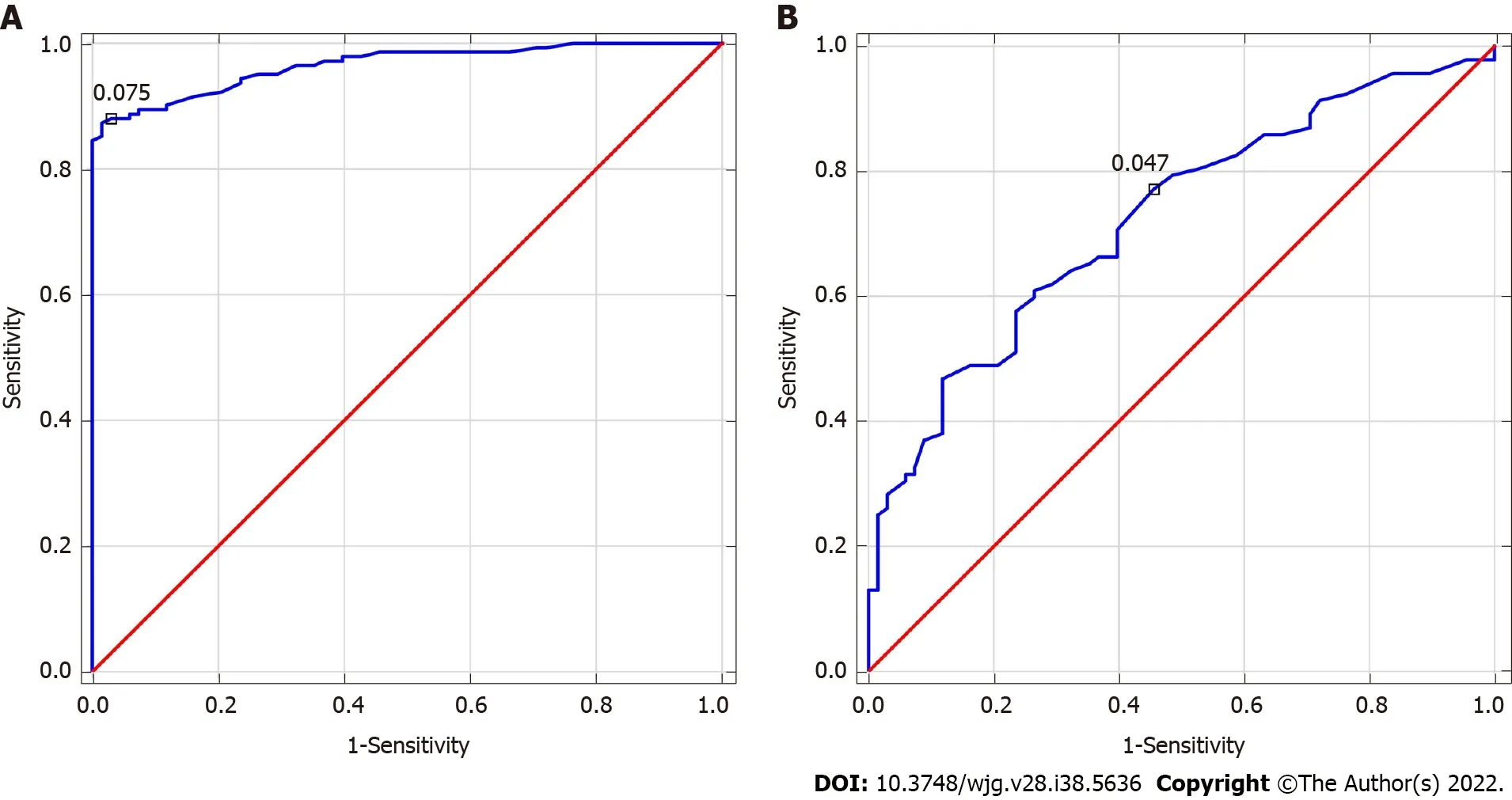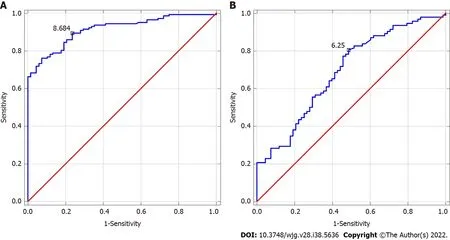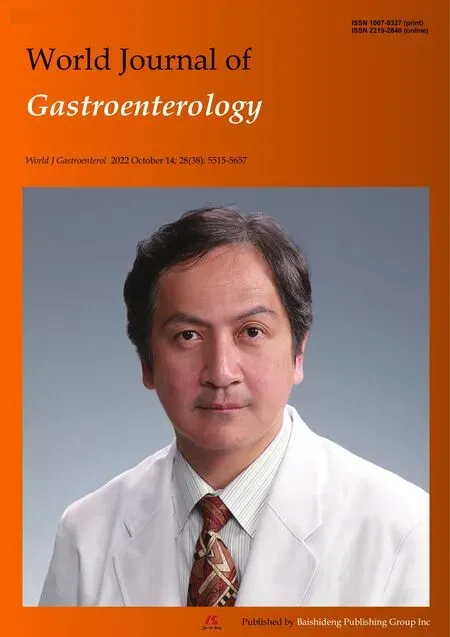Red blood cell distribution width derivatives in alcohol-related liver cirrhosis and metabolic-associated fatty liver disease
Agata Michalak,Malgorzata Guz, Joanna Kozicka,Marek Cybulski,Witold Jeleniewicz,Tomasz Lach, HalinaCichoz-Lach
Abstract
Key Words: Hematological indices; Alcohol-related liver cirrhosis; Metabolic-associated liver disease; Red blood cell distribution width; Red blood cell distribution width-to-platelet ratio; Red blood cell distribution width-to-lymphocyte ratio
lNTRODUCTlON
Alcohol-related liver cirrhosis (ALC) and metabolic-associated fatty liver disease (MAFLD) belong to pathologies with an undeniable global impact. Their monitoring and prediction of a possible outcome are of crucial importance. Due to the progress in hepatology and increased access to new imaging techniques, the evaluation of advanced liver fibrosis (even without a biopsy) turned out to be available.Nevertheless, liver elastography in an ultrasound or magnetic resonance mode are not commonly accessible tools in all medical centers. Direct and indirect markers of liver fibrosis obtained from the blood still remain quite trustworthy indices, but they are not perfect, either. Thus, looking for potentially novel parameters of liver disease progression is a key goal in the field of hepatology[1-4].The most meaningful and valuable future diagnostic tools are new noninvasive blood markers of liver fibrosis; red blood cell distribution width (RDW) together with RDW-to-platelet ratio (RPR) were suggested to be such probable indices. Nevertheless, their probable role in the course of liver steatosis has been poorly explored. RDW reflects the diversity of red blood cells in volume and size. It is obtained from automated hematology analyzers in everyday clinical practice. In the past, RDW was clinically applied only to diagnose anemia or related maladies. Nowadays the spectrum of its possible clinical performance has been significantly broadened. RDW and RPR have already been proven to achieve higher levels in the course of the neoplastic process, being connected with an overall poor survival (e.g.,in the course of cervical, colorectal and prostate cancers), as well[5-7]. Cardiovascular disorders and stroke constitute other pathologies that were explored in the context of RDW. Its high level was even proved to be associated with a 3-mo poor functional outcome in the course of thrombolytic therapy due to acute ischemic stroke. RDW was additionally described as a marker of acutely decompensated chronic heart failure and an indicator of increased mortality among critically ill patients with myocardial infarction[8-11]. Of note, except for RDW derivatives, hematocrit was found to be inseparably connected with the development of atherosclerosis (evaluated as internal carotid intimamedia thickness) in MAFLD patients, suggesting a common potential role of hematological markers -not only in MAFLD, but also due to MAFLD-followed cardiovascular disorders[12]. Thus, RDW derivatives can be perceived as systemic markers of various pathologies. Moreover, according to previously conducted studies, RDW and RPR can even correlate with MELD score and are suggested to behave as markers of poor survival in patients with chronic liver pathologies. RDW-to-lymphocyte ratio(RLR) appears to be a relatively uninvestigated parameter in patients with liver disorders[13-16]. We suspect that no survey to date has explored the diagnostic role of RDW derivatives and their relationships with serological indices of liver fibrosis in the course of ALC and MAFLD. Furthermore,our investigation appears to be the first one performed on Polish patients to evaluate existing dependences between hematological indices and serological markers of liver fibrosis.

Figure 1 Flow chart demonstrating the selection of study participants. ALC: Alcohol-related liver cirrhosis; ΜAFLD: Μetabolic-associated fatty liver disease; US: Ultrasound.
MATERlALS AND METHODS
The survey was accepted by the local ethics committee of the Medical University of Lublin (No. KE-0254/86/2016) and all participants signed an informed written consent on the basis of the Helsinki Declaration for the procedures they followed.
Materials
The investigation was conducted retrospectively on 302 persons. The study group was formed by 142 patients with ALC and 92 with MAFLD. The control group was represented by 68 healthy volunteers.Figure 1 displays the selection of the participants included in the survey. Table 1 shows clinical features of the study population. The diagnosis of liver cirrhosis (LC) was established in accordance with commonly used criteria. The doppler mode abdominal ultrasound examination was applied to confirm the presence of portal hypertension (diameter of portal vein ≥ 13 mm). Different underlying factors leading to portal hypertension were ruled out. Panendoscopy was performed in each of the 142 persons belonging to the ALC group - in 126 of them varices in the esophagus or stomach of the different stages were visualized. Ascites was found in 92 of the ALC patients, leading consequently to the paracentesis in 84 of them. None from the study group suffered from hepatic encephalopathy or spontaneous bacterial peritonitis. All persons enrolled to the survey were given 0/9 points on the CHESS scale.Alcohol-related etiology of LC was figured out due to the proven daily intake of pure ethanol more than 30 g. A detailed history of alcohol addiction was obtained directly from the patients or their trustworthy family members. In addition, all included in the study of ALC patients got positive results on theconducted CAGE test. On the other hand, MAFLD was diagnosed according to the previous history,physical examination, laboratory findings and ultrasound imaging. A daily alcohol consumption amount was not greater than 20 g in men and 10 g in women. Disorders potentially responsible for the development of liver steatosis (celiac disease, Wilson's disease, hepatobiliary infections and alpha-1-antitrypsin deficiency) had been ruled out. Diabetes mellitus type 2 was identified among 22 persons.The presence of diabetes mellitus type 1 caused the exclusion from the survey. None of the MAFLD patients was diagnosed with impaired fasting glucose. Forty six of them were found to suffer from arterial hypertension; 84 persons presented features of metabolic syndrome. Viral/autoimmune liver diseases, clinically relevant inflammatory process and anemia constituted other excluding criteria. None of the survey participants was on steroid therapy.

Table 1 Clinical characteristics of study participants
Procedures
Venous blood samples obtained from peripheral blood were collected from all study participants. EDTA was applied to evaluate hematological indices and citrate to evaluate clotting. Biochemical indices were obtained from the blood samples without an anticoagulant. We collected the blood after at least 12 h of fasting. Hematological and biochemical procedures were performed 4 h after blood sample collection.All of the measurements were conducted in the laboratory of Clinical Hospital Number 4, Lublin,Poland. The remaining part of the blood samples, without an anticoagulant, were centrifuged at the speed of 2000gfor 10 min within 15 min after blood collection. The obtained serum was then stored in 1 mL Eppendorf test tubes at the temperature of -80 °C until the evaluation of direct markers of liver fibrosis with ELISA. Among morphotic parameters of the blood, the RDW, RPR and RLR were obtained.The evaluation of indirect indices of liver cirrhosis concerned: Aspartate transaminase to alkaline transaminase ratio (AAR), aspartate transaminase to platelet ratio index (APRI), FIB-4 (fibrosis-4) and gammaglutamyl transpeptidase to platelet ratio (GPR) (GGT to PLT Ratio). MELD score was assessed in the ALC patients and non-alcoholic fatty liver disease (NAFLD) fibrosis score and BARD score were applied to the MAFLD group. Procollagen I carboxyterminal propeptide (PICP), procollagen III aminoterminal propeptide (PIIINP), platelet-derived growth factor AB (PDGF-AB), transforming growth factor-α (TGFα) and laminin belonged to direct indices of liver fibrosis that were measured. Laboratory procedures were performed in the Department of Biochemistry and Molecular Biology, Medical University of Lublin according to the recommended indications. The assessment of PICP and PIIINP was conducted with quantitative ELISA tests. PDGF-AB and TGF-α were evaluated with the use of R&D Systems Quantikine ELISA Kits. Finally, the measurement of the concentration of laminin was possible because of the Takara Laminin EIA Kit without Sulphuric Acid.
Statistical analysis
Statistical analysis of the results was carried out with Statistica 13.0 (StatSoft Polska Sp. z o.o., Kraków,Poland) for Windows system. The demographic characteristics of study participants and findings of laboratory investigations were shown as the mean ± SD and Student’sttest was applied to compare these data. Deviation from normality was assessed with the use of Kolmogorov-Smirnov test. Data collected in the study were shown as the median and range (minimum-maximum). The Mann-WhitneyUtest was applied for between-group comparisons due to non-normal distribution. The correlations were verified with Spearman correlation analyses. All probability values were two-tailed, and a value ofPless than 0.05 was perceived as statistically significant. Receiver operating characteristic (ROC) curves and area under the curve (AUC) values were used to evaluate the sensitivity and specificity of investigated indices and to verify suggested cut-offs of tested markers in ALC and MAFLD patients.

Table 2 Results of used scores in research group

Figure 2 Receiver operating characteristics for red blood cell distribution width. A: Alcohol-related liver cirrhosis (ALC), area under the curve (AUC)= 0.912 (cut-off > 14.2%); B: Μetabolic-associated fatty liver disease (ΜAFLD), AUC = 0.606 (cut-off > 12.8%). Youden index cut-off for red blood cell distribution width in ALC and ΜAFLD groups = 15.1% and 13%, respectively.
RESULTS
Table 2 presents results of applied scores in the research group. Results of hematological parameters are presented in Table 3. The RDW level was above the reference range in both the ALC and MAFLD groups; its level was significantly higher in comparison to the controls (P< 0.0001 andP< 0.05,respectively). RPR and RLR values turned out to be significantly higher among ALC and MAFLD patients compared to the control group (P< 0.0001). Table 3 presents results of indirect and direct indices of liver fibrosis, as well. The medians of AAR, APRI, FIB-4 and GPR were shown to be significantly higher within the ALC group in comparison to the controls (P< 0.0001). Excluding AAR,patients with MAFLD were observed to present notably higher values of all the enumerated above indirect markers of liver fibrosis compared to the control group (P< 0.0001). According to the direct parameters of liver fibrosis, laminin value in the course of ALC was importantly higher than in the control group (P< 0.05). Except for PICP, medians of PIIINP, PDGF-AB and TGF-α had notably lower levels (P< 0.01,P< 0.001,P< 0.0001, respectively). Concentrations of TGF-α and laminin in MAFLD patients in comparison to controls were found to be remarkably lower (P< 0.0001). PICP, PIIINP and PDGF-AB medians did not differ in a significant pattern. Table 4 presents noted correlations between evaluated indices in ALC and MAFLD groups. We observed meaningful positive dependences between RPR and indirect parameters of liver cirrhosis - FIB-4 and GPR (P< 0.0001) in the ALC patients. RDW and RPR correlated in a negative pattern with PDGF-AB (P< 0.01 andP< 0.0001, respectively). A positive correlation was found between RPR and MELD scores (P< 0.01). Other positive dependences were observed between: RDW and FIB-4 (P< 0.05), and between RPR and APRI (P< 0.0001), in the MAFLD group. RPR correlated positively with the NAFLD fibrosis scores (P< 0.0001), as well. Table 5 shows diagnostic accuracy of evaluated hematological markers. ROCs describing investigated parameters in the ALC and MAFLD groups are shown below in Figures 2-4. AUC values with suggested cut-offs for RDW, RPR and RLR in ALC patients were: 0.912 (> 14.2%), 0.965 (> 0.075) and 0.914 (> 8.684), respectively. AUC values and proposed cut-offs for RDW, RPR and RLR in the MAFLD groups were: 0.606 (> 12.8%), 0.724 (> 0.047) and 0.691 (> 6.25), respectively.

Figure 3 Receiver operating characteristics for red blood cell distribution width-to-platelet ratio. A: Alcohol-related liver cirrhosis (ALC), area under the curve (AUC) = 0.965 (cut off > 0.075); B: Μetabolic-associated fatty liver disease (ΜAFLD), AUC = 0.724 (cut-off > 0.047). Youden index cut-off for red blood cell distribution width-to-platelet ratio in ALC and ΜAFLD groups = 0.08 and 0.06, respectively.

Figure 4 Receiver operating characteristics for red blood cell distribution width-to-lymphocyte ratio. A: Alcohol-related liver cirrhosis (ALC), area under the curve (AUC) = 0.914 (cut-off > 8.684); B: Μetabolic-associated fatty liver disease (ΜAFLD), AUC = 0.691 (cut-off > 6.25). Youden index cut-off for red blood cell distribution width-to-lymphocyte ratio in ALC and ΜAFLD groups = 11.16 and 6.25, respectively.
DlSCUSSlON
New reliable blood markers required in the evaluation of liver fibrosis and clinical prognosis of cirrhosis are permanently in the interest of scientists. Several years ago, basic hematological indices, used ineveryday life, were proposed as potential candidates in this area,e.g., mean platelet volume, platelet crit and RDW. It is assumed that their linkage with liver disorders is due to the inflammation and the release of interleukin-6, interfering hemolytic anemia, hypersplenism and bone marrow activation. The greatest number of surveys in this area of hepatology seems to concern hepatitis B virus- and hepatitis C virus-related cirrhosis; the ALC and MAFLD patients were not explored as much[17-20]. Moreover, a quick diagnosis and further staging of liver steatosis is also a crucial goal nowadays, due to the global prevalence of MAFLD together with its possible severe consequences. RDW derivatives require further investigations in the context of liver disorders. Being the marker of red blood cells heterogeneity, RDW was commonly used as an indicator of anemia. However, it turned out that its potential role can be even more complex. Former surveys proved that the progression of liver cirrhosis is accompanied by an increase in RDW and its elevation might even be a marker of poor prognosis. Similar observations were made with reference to its derivative - RPR. Recent meta-analyses by Caiet al[21] and Milaset al[22]confirmed these data. RDW and RPR were even found to be markers of increased mortality in ALCpatients - independently of MELD score. Lately, RDW elevation was found to accompany severe inflammation and liver fibrosis in three independent studies on autoimmune hepatitis patients[23-25]. RDW was even proposed as a prognostic marker in the course of hepatocellular carcinoma[26,27]. What is more, recently a higher level of RLR has been explored as a potential marker of its recurrence[28]. In our ALC group, RPR correlated positively with MELD score and the diagnostic accuracy of both: RDW and RPR turned out to be high (AUC = 0.912 and AUC = 0.965, respectively). A close relationship between RDW derivatives and indirect indices of liver fibrosis in the course of cirrhosis was already established and our results support this association. However, it seems that previous surveys did not explore relationships between RDW derivatives and indirect parameters of liver fibrosis. According to the available literature, we are the first to note a negative correlation between PDGF-AB concentration and both: RDW and RPR levels in the course of ALC. RLR appears to be explored so far, among liver pathologies, only in the course of primary biliary cholangitis (PBC) and in people affected with acute hepatitis E virus (HEV) infection. Its diagnostic accuracy in the assessment of liver fibrosis in PBC patients and in the diagnosis of HEV infection in symptomatic patients was better compared to APRI,FIB-4 and RPR[29-31]. Our study appears to be the first one concentrating on the role of RLR in ALC and MAFLD. Interestingly, its diagnostic accuracy in the ALC patients turned out to be very high (AUC= 0.914). The data on RDW derivatives in MAFLD patients are very limited. However, previous research observed that elevation in RDW can be assumed as a sign of the progression of simple steatosis to steatohepatitis and the progression of liver fibrosis in the course of MAFLD[32-36]. In our examined MAFLD patients, RPR correlated positively with indirect parameters of liver fibrosis and NAFLD fibrosis score, however, its diagnostic accuracy was quite disappointing (AUC = 0.606). In our survey,we did not aim to perform the comparison of selected hematological markers between the ALC and MAFLD patients. The purpose of our study was to find out whether deviations in certain hematological parameters might accompany an isolated liver steatosis. Our investigation focused on the population of people with MAFLD without the evaluation of possible features of hepatitis in liver biopsy. In the future, we would like to differentiate patients with a simple steatosis and already developed steatohepatitis confirmed by liver biopsy in the context of potential deviations among hematological markers.

Table 3 Results of indirect and direct markers of liver fibrosis together with hematological markers in examined patients

Table 4 Correlations between examined parameters in examined alcohol-related liver cirrhosis and metabolic-associated fatty liver disease patients
CONCLUSlON
In conclusion, our study gives a new insight into the tight relationship between serological indices of liver fibrosis and RDW derivatives in patients with liver pathologies. Especially, RLR seems to be a valuable unexplored parameter in the course of ALC. Its high diagnostic accuracy in our ALC patients is a promising message for subsequent studies. Undoubtedly, this direction of research should be continued to define a potential role of commonly accessible RDW derivatives as indicators of liver disorders in everyday clinical life.

Table 5 Diagnostic accuracy of hematological indices in examined alcohol-related liver cirrhosis and metabolic-associated fatty liver disease patients
ARTlCLE HlGHLlGHTS


Research results
RDW, RPR and RLR values were significantly higher in ALC and MAFLD patients in comparison to controls. RPR correlated positively with MELD score and indirect parameters of liver fibrosis in the ALC group. RPR correlated positively with the NAFLD fibrosis score and APRI in the MAFLD patients; a positive dependency was noted between the RDW and FIB-4. The AUC values and suggested cut-offs for RDW, RPR and RLR in ALC patients were: 0.912 (> 14.2%), 0.965 (> 0.075) and 0.914 (> 8.684),respectively. AUC values and proposed cut-offs for RDW, RPR and RLR in MAFLD patients were: 0.606(> 12.8%), 0.724 (> 0.047) and 0.691 (> 6.25), respectively.
Research conclusions
Our study gives a new insight into the tight relationship between serological indices of liver fibrosis and RDW derivatives in ALC and MAFLD patients. RLR seems to be a valuable unexplored parameter in the course of ALC patients. Its high diagnostic accuracy in ALC is a promising message for subsequent studies. Undoubtedly, this direction of research should be continued to define a potential role of commonly accessible RDW derivatives as indicators of liver disorders in everyday clinical life.
Research perspectives
It seems that our results have important clinical implications and could be applied in everyday diagnostics of patients with liver disorders.
FOOTNOTES
Author contributions:Michalak A, Lach T and Cichoż-Lach H prepared data; Michalak A and Cichoż-Lach H invented and conducted the study; Guz M, Kozicka J and Jeleniewicz W applied the experiments, gained and interpreted data; Cybulski M statistically analyzed the data; Michalak A and Cichoż-Lach H wrote the article; All authors accepted the current version of the manuscript.
lnstitutional review board statement:The survey was accepted by the local ethics committee of the Medical University of Lublin (No. KE-0254/86/2016).
lnformed consent statement:All study participants, or their legal guardian, provided informed written consent prior to study enrollment.
Conflict-of-interest statement:All the authors report no relevant conflicts of interest for this article.
Data sharing statement:No additional data are available.
STROBE statement:The authors have read the STROBE Statement-checklist of items, and the manuscript was prepared and revised according to the STROBE Statement-checklist of items.
Open-Access:This article is an open-access article that was selected by an in-house editor and fully peer-reviewed by external reviewers. It is distributed in accordance with the Creative Commons Attribution NonCommercial (CC BYNC 4.0) license, which permits others to distribute, remix, adapt, build upon this work non-commercially, and license their derivative works on different terms, provided the original work is properly cited and the use is noncommercial. See: https://creativecommons.org/Licenses/by-nc/4.0/
Country/Territory of origin:Poland
ORClD number:Agata Michalak 0000-0003-4426-6321; Małgorzata Guz 0000-0001-6783-8017; Joanna Kozicka 0000-0002-3094-8789; Marek Cybulski 0000-0003-0540-1199; Witold Jeleniewicz 0000-0003-1423-0504; Tomasz Lach 0000-0003-1370-7657; Halina Cichoż-Lach 0000-0002-7337-835X.
S-Editor:Gao CC
L-Editor:Filipodia
P-Editor:Gao CC
 World Journal of Gastroenterology2022年38期
World Journal of Gastroenterology2022年38期
- World Journal of Gastroenterology的其它文章
- Ultrasound-based artificial intelligence in gastroenterology and hepatology
- Comparison of evaluation indexes for Gastroenterology and Hepatology journals in different databases
- A new scoring system to evaluate adjuvant chemotherapy for patients with T2N0M0 gastric cancer after D2 gastrectomy
- Timing of endoscopic retrograde cholangiopancreatography in the treatment of acute cholangitis of different severity
- Effect of low-dose radiation on thyroid function and the gut microbiota
- Oxidative stress bridges the gut microbiota and the occurrence of frailty syndrome
